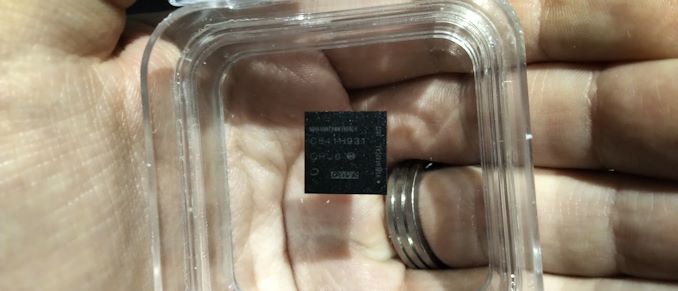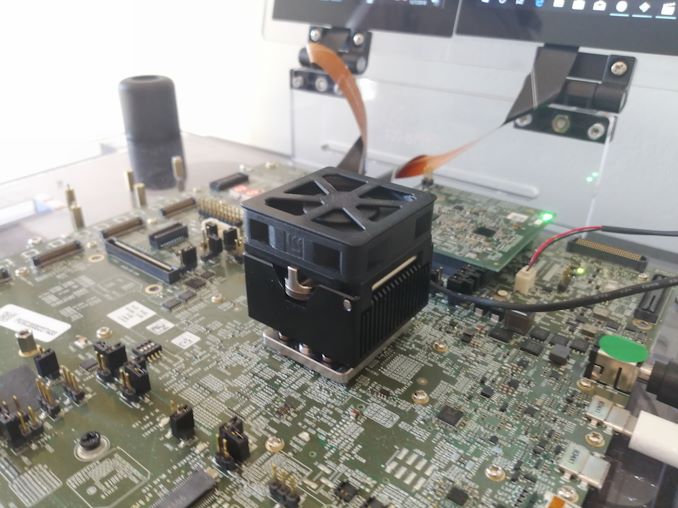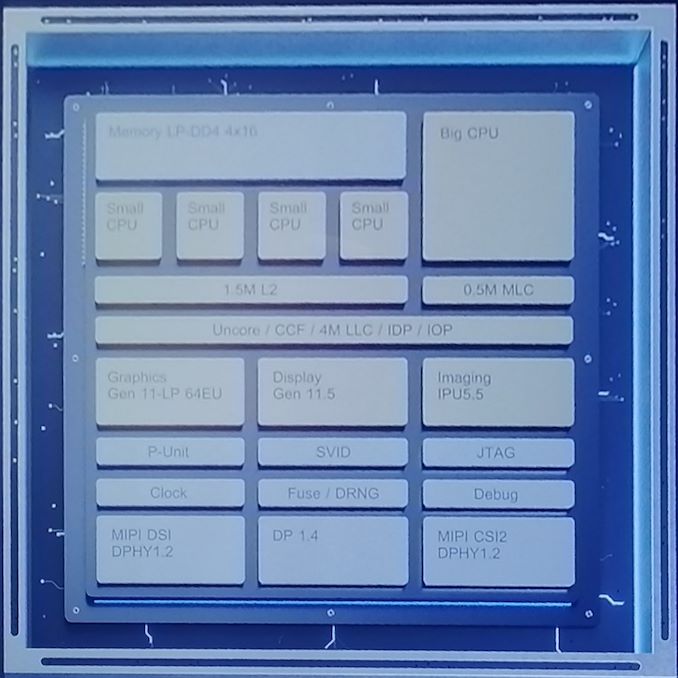Intel's Architecture Day 2018: The Future of Core, Intel GPUs, 10nm, and Hybrid x86
by Dr. Ian Cutress on December 12, 2018 9:00 AM EST- Posted in
- CPUs
- Memory
- Intel
- GPUs
- DRAM
- Architecture
- Microarchitecture
- Xe
Intel’s First Fovoros and First Hybrid x86 CPU: Core plus Atom in 7 W on 10 nm
Perhaps someone will correct me, but I can’t ever remember a time when Intel has put multiple x86 cores of different configurations on the same bit of silicon (ed: Intel Edison). Ever since Arm starting doing it with its big.Little designs in smartphones, a perennial question was if Intel was going to do something similar, either with big and small Atom cores, or by moving a high-performance Core into the mix. When Intel left the smartphone and tablet market, we assumed the idea was dead. But, like a reanimated zombie, it has risen from the grave. Enter Intel’s Hybrid x86 CPU.
This tiny 12x12 package is built using Intel’s Fovoros technology, using a 22FFL IO chip as the active interposer connected with TSVs to a 10nm die that contains both a single Sunny Cove core and four Atom (Tremont?) cores. This tiny chip is smaller than a dime, and is designed to have a 2 mW standby power. It would appear that this chip is destined for mobile devices.
Here’s the manufacturing diagram, showing the idea that POP memory is placed over the Fovoros design to give the final product. Very much like a mobile chip.
The demo system that Intel had on display looked similar to the previous Sunny Cove design, however this heatsink was smaller and it had a few different connectors. We were told that this chip will support PCIe for M.2 as well as UFS, both of which are found in mobile. There also looked like a couple of SIM card connectors on this motherboard.
The key part of this discussion however is this block diagram that was on one of the Intel slides. Here we see a single ‘Big CPU’ with 0.5 MB of private medium level cache, four ‘Small CPU’s with a shared 1.5 MB L2 cache, an uncore that has 4MB of last level cache, a quad-channel memory controller (4x16-bit) with support for LPDDR4, a 64 EU design with Gen11 graphics, the Gen 11.5 display controller, a new IPU, MIPI support with DisplayPort 1.4, and all of this in a tiny package.
Seriously though, this has the potential to be a large revenue stream for Intel. They’ve made this chip, which allows the cores to enter C6 sleep states when not in use, that has a die size smaller than 12x12mm (144 mm2), and target the sub-7W fanless device market. That’s with a big Core, four Atom cores, and a GT2 64 EU design.
Intel actually says that the reason why this product came about is because a customer asked for a product of about this performance but with a 2 mW standby power state. In order to do this, Intel created and enhanced a number of technologies inside the company. The final product is apparently ideal for the customer, however the chip will also be made available for other OEMs.
In our Q&A session with the senior members of Intel, it was clear that this technology is still in its infancy, and Intel now has a new toy to play with. Jim Keller stated that internally they are trying lots of new things with this technology to see what works and what would make a good product, so we should be seeing more Foveros designs through 2019 and 2020.















148 Comments
View All Comments
iwod - Thursday, December 13, 2018 - link
Except external GPU.Icehawk - Thursday, December 13, 2018 - link
The number of those sold can be counted on one hand. Ok, maybe two,In all my years I've used a FW cable exactly once.
I've seen a total of two thunderbolt cables, our Mac guy had them for some crap he was doing. IOW, dead just like FW. Proprietary stuff just doesn't tend to last long in an open, commodity, market when equivalents are available for free or pennies on the dollar.
dampf - Wednesday, January 2, 2019 - link
Because nobody knows about it. I'm sure there is a big market for that, just connect a GPU to your laptop via thunderbolt 3 and enjoy high end gaming!johannesburgel - Thursday, December 13, 2018 - link
Nonsense, it's exactly the other way around. Everything is converging on PCI Express. Every peripheral which can actually profit from USB3 speeds would be better off with a direct PCI Express connection instead, and Thunderbolt can do that. USB3 on the other hand requires protocol conversion on both ends of the cable. Instead of being able to just plug a normal GPU, an off-the-shelf NVMe SSD or any other standard device into an external enclosure, without any hardware or driver adaptions, people have to come up with USB3 interface chips and special USB variants of every device.USB3 never had a reason to exist.
HStewart - Thursday, December 13, 2018 - link
I guess you have never truly experience Thunderbolt - it has 40G rate compare USB 3.0 and currently drives a doc - powering multiple monitors plus multiple devices - also remember that it is a superset of USB C Gen 2.Not to mention it has external GPU via PCIe.
HStewart - Thursday, December 13, 2018 - link
TB3 is open up - I believe I saw some foreign TB3 controller out there - but there maybe support issue -Gc - Thursday, December 13, 2018 - link
_eX
looks like it stands for x'ellerator, for many hardware accelerator markets, not just gaming.
Visually, it looks like a tuxedoed figure skater X holding up Microsoft's 'e'.
Samus - Thursday, December 13, 2018 - link
“a customer asked for a product of about this performance but with a 2 mW standby power state. In order to do this, Intel created and enhanced a number of technologies inside the company. The final product is apparently ideal for the customer, however the chip will also be made available for other OEMs.”Clearly Apple.
StrainedDig4 - Thursday, December 13, 2018 - link
Is there a reason when I expand the text screen your video Ads pop up onto the screen, refuse to quit and obscure 1/4 of the display? Are your readers displeasure less important than advertising dollars? I don’t read your articles to buy things, I have Amazon for that, I read to become more informed. Kindly let me know why your pages have become Tomshardware.com lookalikes...ajc9988 - Thursday, December 13, 2018 - link
advertising dollars keep the lights on and pay the salaries of the authors of these articles. Without ads, you don't get to read the content for pleasure, and then it all is a moot point, now isn't it. With that said, could you give constructive criticism on how they could make it less intrusive while still accomplishing the same goal?